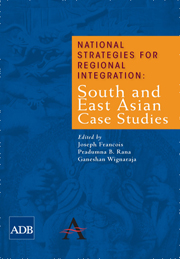1 - Introduction Findings and Policies
Published online by Cambridge University Press: 05 March 2012
Summary
Setting and Purpose of Study
East and South Asia include some of the world's most dynamic open economies as well as several least developed countries. This study examines the diverse experience of regional integration of a sample of South and East Asian economies. Using a set of country cases based on a similar framework, the study addresses an important policy question: how can each country's integration with its neighbors and more distant regional economies be improved? Of the eight country studies, five are from South Asia (India, Pakistan, Bangladesh, Nepal, and Sri Lanka) and three are from East Asia (the People's Republic of China [PRC], Thailand, and Singapore). The country cases–which differ by per capita income, economic growth rate, country size, and location–provide fascinating insights into the relationship between regional economic performance and strategies for regional integration at country level. The study also offers lessons for other countries and subregions which are interested in developing national strategies to foster pan-Asian integration. As the next section shows, relations between South and East Asian economies have evolved considerably since pre-colonial times. The country cases focus on the period since 1990, as this period marks the beginning of strengthening integration between South and East Asian economies. The global economic crisis is expected to have a temporary, short-term negative impact on the process of South Asia-East Asia integration. Once global economic recovery commences, the pace of South Asia-East Asia integration is expected to pick up.
- Type
- Chapter
- Information
- National Strategies for Regional IntegrationSouth and East Asian Case Studies, pp. 1 - 22Publisher: Anthem PressPrint publication year: 2009



